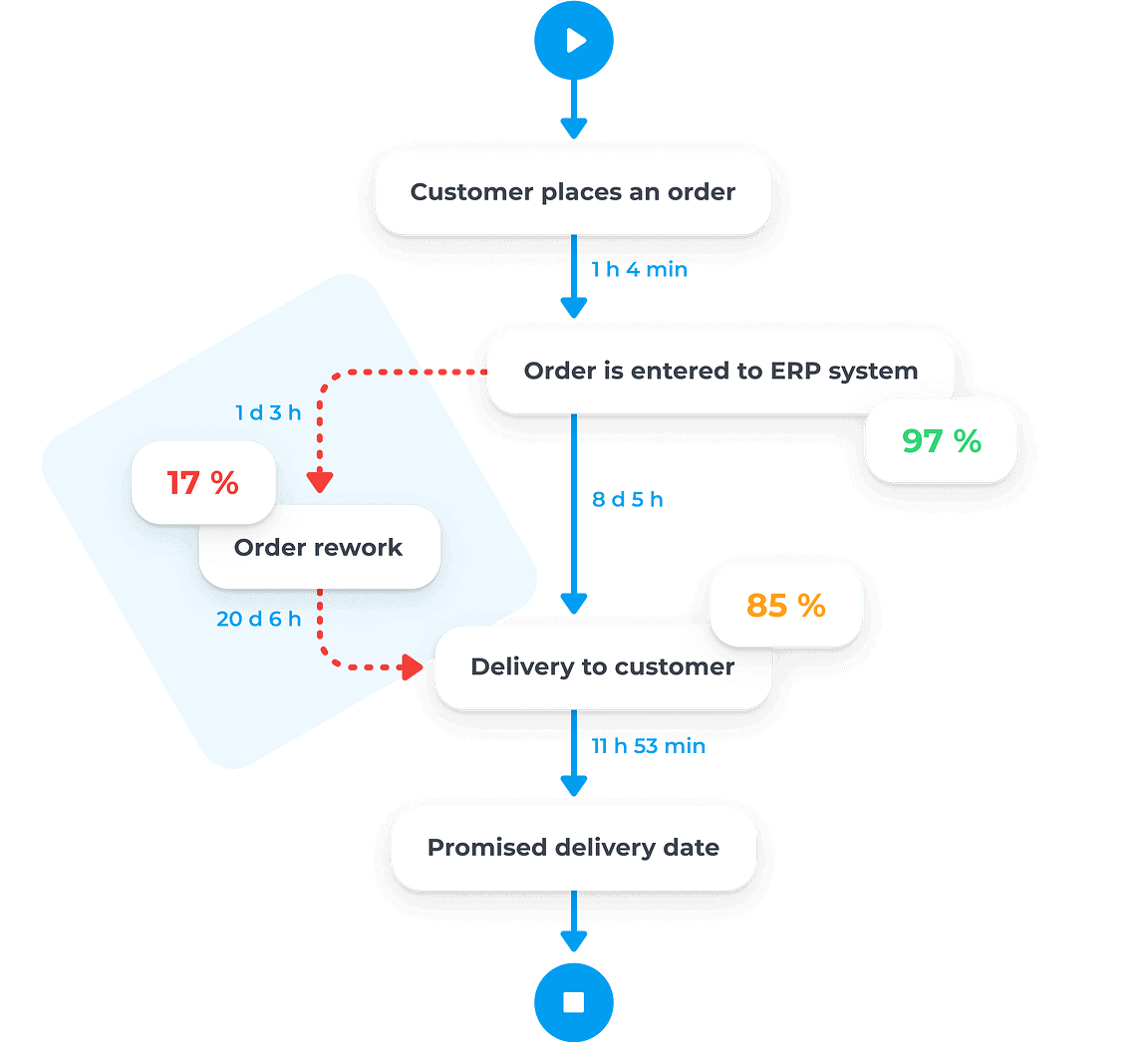Apply automation where it does the most for you
Intelligent automation (i.e., combining RPA with advanced technologies like AI-based process mining) is the only way for you to create truly resilient and efficient end-to-end processes. Process mining with QPR ProcessAnalyzer helps you in every step of your automation roadmap.
Use process mining to:
End-to-end visibility
Get end-to-end visibility to your processes and see how they contribute to concrete business outcomes.
Value of automation
Prove the value of automation or system changes easily – your case can be supported by the click of a button.
Predict and prevent
Predict and prevent process failures with intelligent ML-functionalities and monitor the right KPIs continuously.
Prioritize automation opportunities
View a list of prioritized automation opportunities in your processes and view the value of deployed automation.
Get a detailed understanding of your processes
Process mining can play a critical role in helping organizations implement intelligent automation.
It involves extracting information from event logs, such as system data and process execution data, to create a visual representation of the process.
With process mining, you get a detailed understanding of how business processes are being executed, which can be used to identify areas where automation can be introduced to improve efficiency and reduce costs.

Spot error-prone, repetitive or manual tasks
One way that process mining is used to support intelligent automation is by providing visibility into processes that are currently being performed manually.
This helps organizations to identify opportunities for automation, such as tasks that are time-consuming, error-prone, or repetitive in nature.
By identifying these tasks and automating them, organizations can reduce the need for manual labor and improve accuracy.
Monitor and measure the efficiency of automation
In addition, process mining can be used to monitor and measure the effectiveness of automation.
By providing a detailed understanding of how processes are being executed before and after automation, it can help organizations to identify any unintended consequences and make adjustments as needed.
7 ways in which process mining adds value to intelligent automation
Are your processes ready for intelligent automation? Without Agentic AI and process mining, automation risks accelerating inefficiencies instead of eliminating them. Process mining delivers the insights needed to build resilient, efficient, end-to-end automation.

Prioritize your automation roadmap
Get a prioritized list of the best automation opportunities in your organization with the automation analysis application.
Test out the impact of your automation plans before implementation. This feature helps you build a business case for automation when you are looking into new automation possibilities.
Understand at what rate your activities are automated and how they vary between different parts of the organization. Use these insights to look for best practices and to focus your automation journey.
Realize and increase automation value
Enjoy the benefits of automation faster than ever by automatically finding the simplest mature processes and activities to focus your automation efforts in and save time in automation implementation.
Support the continuous success of your automated yet ever-changing processes. Activate bots, workflows, and automation to take action before things go wrong.
Instead of only focusing on automation statistics, QPR ProcessAnalyzer enables you to easily monitor and realize the effect that automation has on your end-to-end business performance.
About QPR ProcessAnalyzer
- Put an end to lengthy process workshops, interviews, and arguments. Get everyone on the same page by automatically visualizing the real-life execution of your processes.
- See all process bottlenecks, inefficiencies, and variations and how they contribute to business outcomes.
- Find the cause of your problems and spot the most important improvement areas in any process with the comprehensive, industry-leading Root Cause analysis.
- See the top automation opportunities in priority order, benchmark automation rates across your organization, and simulate the impact of automation.
- Use the AI Assistant to ask questions, analyze your KPIs, and understand your processes with ease.
- Rely on the AI Agent to provide recommendations and trigger corrective actions – keeping your business resilient and efficient in real time.
- Enterprise-grade security with ISO27001, encryption, and SSO – powered by Snowflake’s unmatched scalability and performance.
Trusted by leading global companies
"We get total visibility to our processes and data, there’s no longer a need for extrapolation and assumptions based on sampling."

Aurora Sunna, Advanced Audit Automation Analyst
Wärtsilä
“Thanks to QPR, we were able to demonstrate process bottlenecks to the broader management, identify optimization points and make recommendations to improve the consumer loan process.”

Lambros Bessas, Senior Manager
Piraeus Bank
“ProcessAnalyzer essentially helped us to create a better workplace for our employees because we removed uncertainties from our business processes, and thereby from everyone’s work day. Better processes mean more peace of mind at work.”

Matti Ketonen, VP of Supply Chain
MetsäBoard
"Process mining is going to tell you exactly where the problem is. This gives management, process owners, and business analysts a lot of information that they never had in the past. Now, the information is right at their fingertips."

Nikolay Goldovich, Head of Data, Process and Automation
Sanofi
Guide to Successful Process Optimization
Every action in your IT systems leaves a digital trace.
Process mining turns this data into a clear view of your processes, helping you spot inefficiencies, find the best automation and AI opportunities, and drive continuous improvement.
